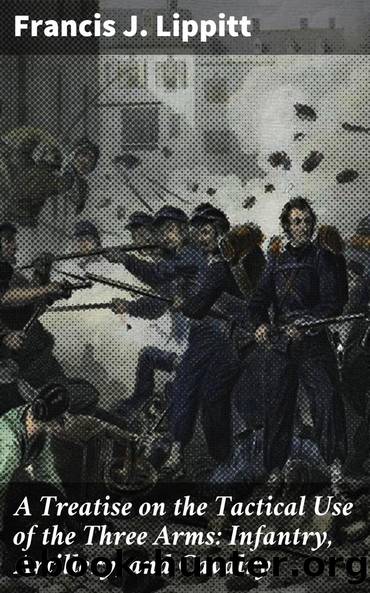A Treatise on the Tactical Use of the Three Arms: Infantry, Artillery, and Cavalry by Francis J. Lippitt

Author:Francis J. Lippitt [Lippitt, Francis J.]
Language: eng
Format: epub
Tags: History, United States, Civil War Period (1850-1877)
ISBN: 9781484006214
Google: sJ61ngEACAAJ
Publisher: Createspace Independent Pub
Published: 2013-03-31T00:53:38+00:00
IV.âPosting of Batteries and of Pieces as between themselves.
Table of Contents
1. The best mode of posting batteries is in the form of a crescent, its horns pointing towards the enemy, or forming the sides of a re-entering angle; for this gives a convergent fire to the enemy's divergent one.
Its inconvenience is, the exposure of its flanks to attack, or to enfilade. Therefore, when such a position is adopted, its flanks must be protected by natural obstacles or by artificial defences.
2. Batteries, or parts of batteries, should be at supporting distances from each other; that is, not over six hundred yards apart, so as to effectually cover the whole ground between them, in case of need, with grape and canister. When rifled guns are used, this distance may be increased.
3. A long line of guns in our line of battle is objectionable; for, if it should become necessary to withdraw them, they would leave a dangerous interval.
4. It is dangerous to collect a great many pieces in one battery, especially in the beginning of an action, when the enemy is fresh, for it strongly tempts him to capture it. When used, such a battery should have powerful supports to protect it, or should be sheltered by a village, a defile, or other cover, occupied beforehand.
5. Although, to be used offensively, guns should be in strong masses, in order to strike a decisive blow on some single point; this is by no means the case when used defensively; for,
(1.) It is only when guns are more or less scattered over different parts of the field, that they can be made to give a cross-fire on the enemy's advancing columns, or on any part of his line.
(2.) If the position where they are massed does not happen to be attacked, they become useless, while stripping the rest of the line.
(3.) If they are captured, all the artillery is lost at once, as happened to the Austrians at the battle of Leuthen, causing their defeat.
6. A certain number of pieces of horse-artillery must always be kept in reserve, so that, if an artillery fire at any point should be suddenly wanted, it may be furnished with the least possible delay.
7. Guns of various calibres should never be in the same battery, to prevent confusion as to the respective ranges, and in the supply of their ammunition.
8. An independent section or battery should never consist of howitzers alone, for the proper fire of these pieces is too slow to be effective in repulsing an attack on them.
9. There should always be wide intervals between the pieces; otherwise the battery would offer too good a mark to the enemy.
Download
This site does not store any files on its server. We only index and link to content provided by other sites. Please contact the content providers to delete copyright contents if any and email us, we'll remove relevant links or contents immediately.
The Radium Girls by Kate Moore(10945)
The Templars by Dan Jones(4211)
100 Deadly Skills by Clint Emerson(4109)
Rise and Kill First by Ronen Bergman(4049)
The Doomsday Machine by Daniel Ellsberg(3760)
The Rape of Nanking by Iris Chang(3549)
Killing England by Bill O'Reilly(3479)
Hitler in Los Angeles by Steven J. Ross(3463)
Stalin by Stephen Kotkin(3108)
12 Strong by Doug Stanton(3072)
Hitler's Monsters by Eric Kurlander(2752)
Darkest Hour by Anthony McCarten(2666)
Blood and Sand by Alex Von Tunzelmann(2623)
The Art of War Visualized by Jessica Hagy(2432)
Hitler's Flying Saucers: A Guide to German Flying Discs of the Second World War by Stevens Henry(2313)
The Code Book by Simon Singh(2237)
The Second World Wars by Victor Davis Hanson(2144)
Babylon's Ark by Lawrence Anthony(2086)
Tobruk by Peter Fitzsimons(2073)
